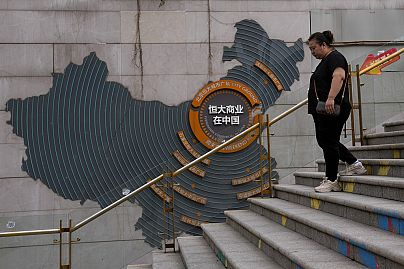With China continuing to see disappointing economic data, European markets may suffer as Chinese exports and investments fall.
China’s economy could be giving us mixed signals with the post-pandemic recovery possibly tapering off as stimulus measures trickle away.
On the one hand, exports are falling and inflation is in negative territory. On the other hand, commodity imports are still strong and third quarter (Q3) gross domestic product (GDP) has picked up as well.
The country’s economic recovery is likely to have a significant impact on European markets, via a number of different avenues. These include imports and exports, energy, investments and more.
The last few years have taken their toll on China, with the country facing one of the worst outbreaks of the coronavirus, which led to extended lockdowns and a slew of zero-Covid measures. During this time, China’s real estate and property sector was also severely undermined by Evergrande’s near collapse.
Slew of weak Chinese data could cause waves in Europe
China’s October exports fell 6.4% year-on-year, marking the sixth consecutive month of declines. This could spell bad news for the European Union, as it imports about 20% of its goods from China, which is also its third largest export partner, accounting for about 9% of EU exports. Domestic production in China is also lagging somewhat, making fewer goods available overall.
The year-on-year inflation rate for October came in at -0.2%, below September’s 0% as well as consensus estimates of -0.1%. This shows that domestic demand is still struggling considerably, especially as consumer sentiment dampens over the housing crisis.
Deflation, such as China is seeing at the moment, can lead to the value of debt becoming more expensive. As a result, governments, as well as companies and individuals may find it more difficult to make repayments.
With key real estate companies in China already struggling to make dollar bond payments on time, this could quickly become a slippery slope. If so, the shockwaves would be heavily felt in Europe as well.
Even now, European stock markets already feel the pain every time significant new Chinese economic data hits the market, such as GDP, retail sales, exports and inflation prints. This is due to a number of European companies being reliant on China at some point or the other in their supply chain.
China’s stuttering recovery has also caused a dip in its investments in Europe. As of April 2022, China’s foreign direct investment (FDI) in Europe reached its lowest level in a decade, coming to about €7.9 billion.
Could the tide now be turning?
However, it looks like there might be a silver lining in the midst of gloomy Chinese data after all. GDP in the third quarter of 2023 advanced 4.9% year-on-year, more than analyst expectations of 4.4%.
Although this is at odds with inflation and demand data, it could point towards manufacturers starting to find their feet again. This follows a long period of production cuts due to zero-Covid measures, higher energy prices and increased raw material costs.
A stronger case could also be made for new and more consistent stimulus measures, following China’s latest underwhelming inflation report. This might further bolster the flagging property sector, while also better supporting the manufacturing and renewable energy sectors. Increased tax breaks may be on the horizon too.
Several banks, such as JPMorgan Chase and Citigroup expect China’s GDP growth for 2023 to be above Beijing’s official target of 5%. JPMorgan has pinned hopes on 5.2% growth, whereas Citigroup estimates 5.3% growth. This could indicate an uptick in global sentiment regarding China’s recovery.
Osama Rizvi, economist and energy analyst at Primary Vision Network said: “China's recovery is probably the biggest theme in the global economy right now and will remain so next year. So far, there have been mixed signals. While stimulus measures have not had the impact expected, commodity imports remain strong.”
He also noted that from a wider perspective, China's economy is doing better than any other economy in the world and the hiccups that it has had are likely to be overcome fairly quickly.
Even if China’s recovery does not recover as expected, Europe may stand to gain in a few ways. In case China’s domestic demand continues to flag, Chinese exporters may attempt to lower international prices, in an effort to secure more consumers abroad. This could work in Europe’s favour, by making Chinese goods even cheaper than before.
Furthermore, China’s recovery stalling could also mean that competition in global energy markets lessens somewhat, which may even cause a drop in energy prices. With Europe still dealing with the effects of the energy crisis, this may come as a relief.
Electric vehicles and critical minerals remain Europe’s strongest link to China
China is the biggest producer of electric vehicles or EVs in the world, accounting for about 5.47 million EVs in 2022. This was a surge of 85.8% since 2020. Not only this, but it is also the largest consumer of electric vehicles, responsible for about 60% of EV sales internationally.
About 8% of the EVs sold in Europe come from China currently, which could escalate to 15% by 2025. Chinese cars are cheaper, with more features and styles. They can be produced much more cheaply as government stimulus measures generously support EV manufacturers.
China also has easy and cheap access to the key components and commodities required to build EVs, such as lithium batteries, as well as a relatively solid and extensive supply chain.
Beijing requires most foreign car manufacturers wanting to set up cheap production in China to tie up with local car companies. This can be a little tricky for some car manufacturers, which is why EV production in China has not seen too many foreign players yet. Tesla was one of the first companies to set up a gigantic production plant in Shanghai, encouraged by subsidies on land, taxes and loans.
With the EU continuing to tighten its climate change and energy transition policies, imports of EVs from China have risen much faster in the last few years. This has also coincided with the exodus of European EV manufacturers to the US, following the US Inflation Reduction Act.
However, this doesn’t mean that the EU is happy about its reliance on Chinese EVs. In October 2023, the European Commission launched an anti-subsidy investigation into the Chinese vehicles imported into the EU. This will take a closer look at the extent of subsidies Beijing provides its EV manufacturers and could potentially make it more expensive for EU importers to import Chinese EVs.
In addition, China also produces about 70% of global lithium-ion batteries, which are key to electric vehicles. This has gone a long way in cementing its position from start to finish in the EV supply chain.
Europe also relies heavily on China for the production and procession of several key rare earth minerals, without which Europe’s green transition would screech to a halt. These include lanthanum, neodymium, cerium, europium and much more.
In 2022, China doubled the supply of its critical minerals from 105,000 tonnes to 210,000 tonnes. These minerals are crucial in the production of low carbon technologies, such as wind turbines, electric vehicles, solar panels and more.
In addition to that, the processing and refining of these metals can be another long, complicated and expensive process. However, China has the first mover’s advantage in this market, having capitalised on its abundant sources of raw materials decades ago. Europe misses both natural resources reserves, in this case, as well as the processing technology and facilities.
This has led to increased fears that the EU’s anti-subsidy measures into Chinese EVs, may in turn lead to aggressive retaliation measures by China in the rare earth minerals market. However, Europe is also looking into other suppliers of critical minerals, such as Australia, in order to reduce its dependency on China.
This is part of a broader initiative to diversify its suppliers and trading partners, following the retaliatory measures by Russia in the aftermath of EU sanctions for the Ukraine war.




















